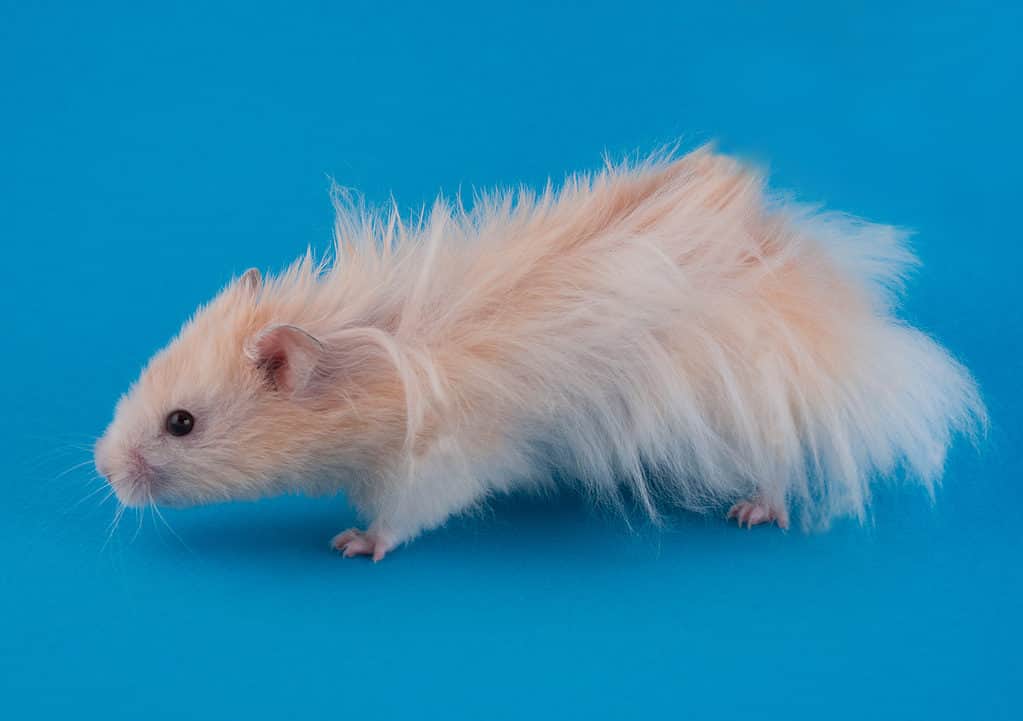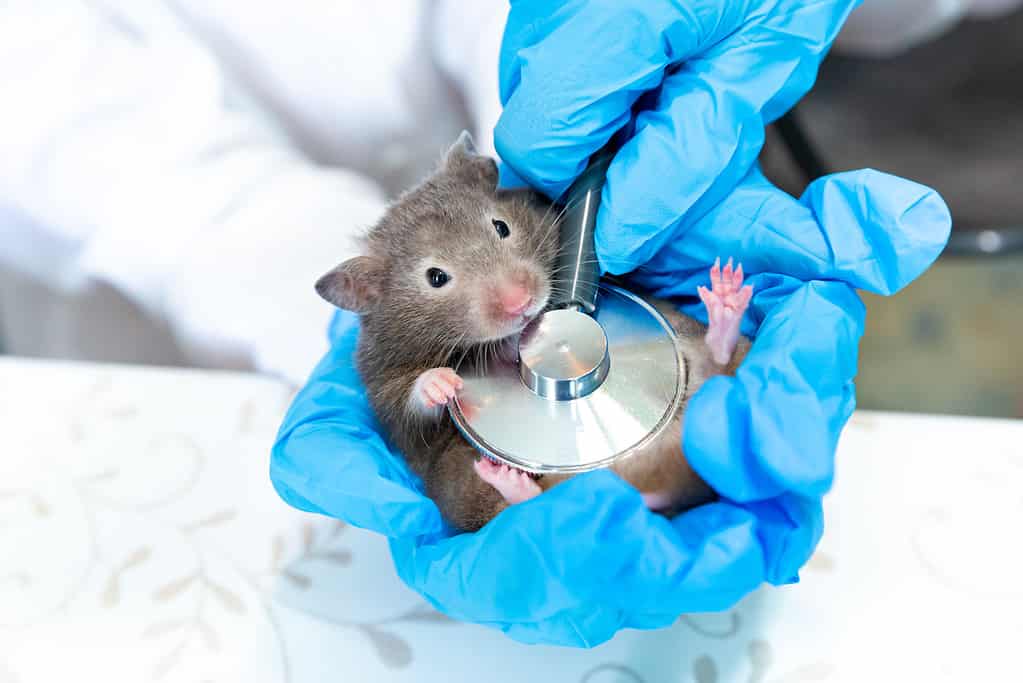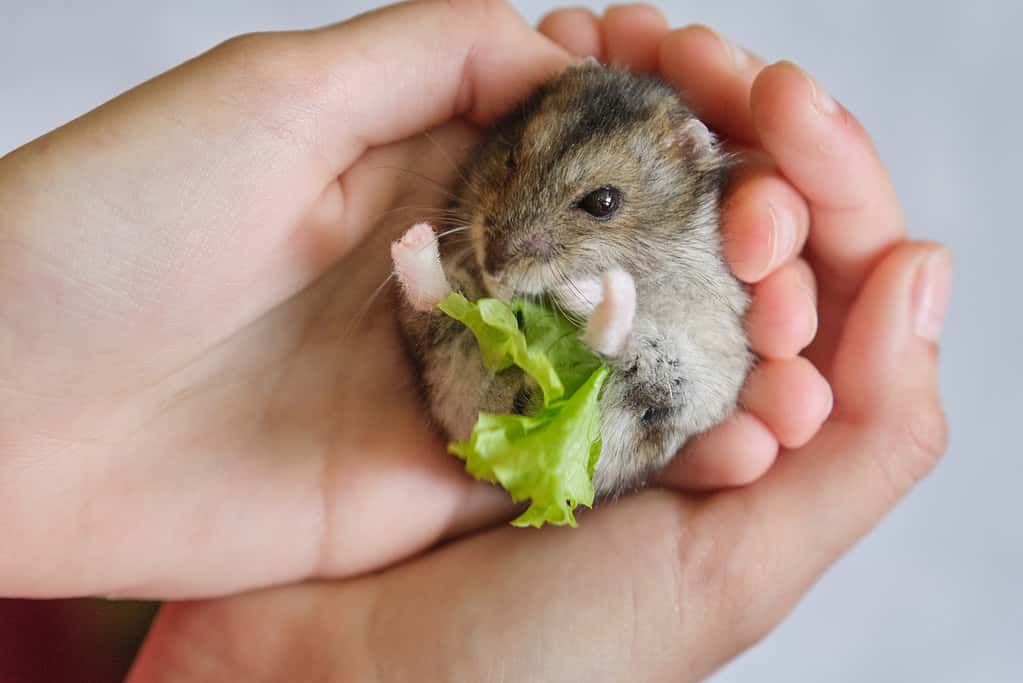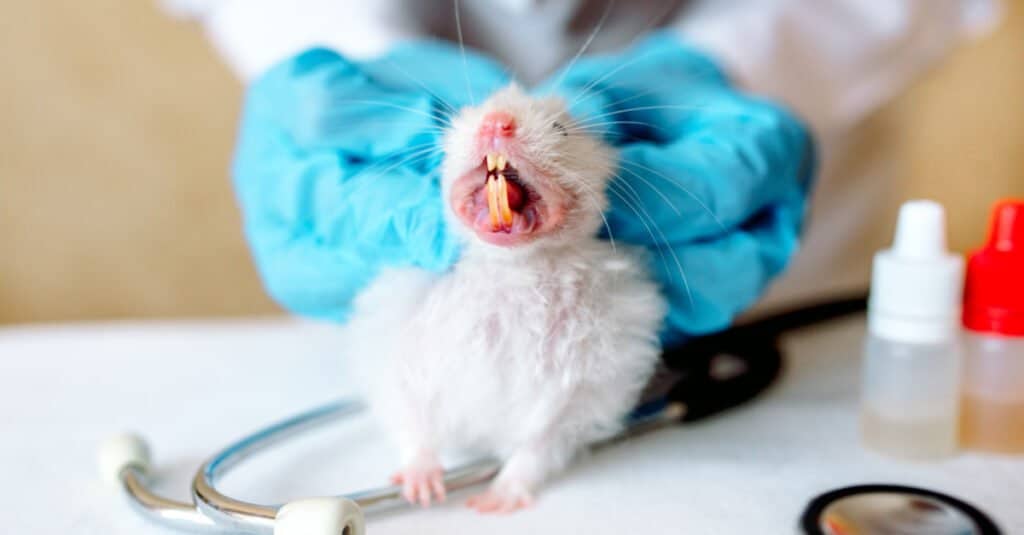Hamsters are popular are relatively low-maintenance pets. They are rodents belonging to the subfamily Cricetinae. The Syrian (or golden hamster), Mesocricetus auratus, is probably the most common. However, several species of dwarf hamsters including Russian Campbell’s hamsters and Roborovsk hamsters are also popular.
The majority of them are very healthy and if looked after correctly can live for several years. However, as is the case with all animals, they are prone to some disorders. It is useful if you can recognize these so that you know when your pet is ill and needs to see a vet. Skin diseases and abscesses, digestive infections and infestations, respiratory infections, cancer, and age-related multi-organ issues can all limit their lives.
How to Tell Your Hamster Is Ill
Sadly, your hamster can’t tell you that they are feeling under the weather. Also, they are prey animals and have evolved to hide signs of illness. This means that you need to be vigilant and on the lookout for signs that they are unwell. It is a good idea for you to get your hamster used to being handled from a young age. This will mean that you can take them out of their cage and examine them now and again. It also makes it less stressful for them to be transported to and examined by the vet. If your pet shows one of the following signs, you should be concerned.
- They have a ‘wet tail’ – this is wet or matted fur around their bottom, tail, or belly.
- Their poop is much looser or watery than normal – diarrhea.
- They have stopped eating.
- They have stopped moving around.
- They are huddled in a corner of their cage.
- Their coat looks scruffy and unkempt or they have lost hair.
- They are making a noise when they breathe or are sneezing.
- They have a discharge coming from their nose or eye.
- They have a lump or bump on their body.
Which hamsters are most likely to be ill?

Baby hamsters are more vulnerable to many diseases.
©iStock.com/Mikhail Davidovich
Hamsters are most vulnerable to getting ill when they have been exposed to ‘stress’. Stress in a hamster can be caused by a change in their environment. It is common for hamsters to become stressed when you first bring them home from the pet store or breeder. This is because transportation and moving into a new cage are very challenging situations for these little animals to deal with. A change in diet is also stressful. This is why it is a good idea to continue with the food that the pet store or hamster was using for a little while. When you do change their diet, make sure that you do it gradually.
Young hamsters are more vulnerable to many infections than mature individuals. Finally, older hamsters are more likely to develop conditions that involve degeneration of their organs such as their liver and kidneys.
All of the conditions listed here need to be checked out by a vet. Many human medications (including some antibiotics) and household chemicals are toxic for hamsters so never attempt to treat your hamster yourself.
1. Hamster Abscesses
An abscess is a pocket of infection. They are often filled with pus which is a yellow-colored fluid made up of white blood cells, blood, and bacteria. Abscesses are usually tender to the touch and are normally found just under the hamster’s skin.
Whilst they can occur on any part of their body, they are often located around the head. They may smell unpleasant and can make your pet feel quite poorly. This may make your pet lethargic and put them off their food. Abscesses usually develop from a wound of some sort which could be a scrape from the cage or a bite wound from another hamster. Your vet may need to drain the abscess, flush it with saline, and treat your pet with antibiotics. When treated promptly, hamster abscesses usually heal. However, if the infection has spread to other parts of the hamster’s body the prognosis is poor. You can prevent abscesses by separating hamsters who fight and by making sure that there are no sharp surfaces that can cause injuries within the cage. Check for this every time you clean your pet out.
2. Ringworm Infections
Ringworm is not caused by a worm but by a fungus. The most common fungal infections in hamsters are caused by Trichophyton mentagrophytes and Microsporum species. You may notice bald patches or crusty flaking skin that is red around the edges. Your hamster may have caught this by being in contact with an infected animal or human or from infected bedding. If your hamster roams around your home, they could also pick it up from here. It is usually treated with a topical or oral antifungal medication. Most ringworm infections in hamsters are not life-threatening, but if left untreated they can lead to a loss of condition. This makes your hamster vulnerable to other, potentially fatal, diseases.
3. Hamster Skin and Fur Mites

Hamsters can get mites on their skin and fur.
©Olena Kurashova/Shutterstock.com
These are common conditions in hamsters. They pick them up from another infested hamster or infested bedding or hay. The two mite species that are common in hamsters are Demodex criceti and Demodex aurati. Male hamsters and older hamsters are more likely to get mites because they are more prone to other diseases which makes them vulnerable to a mite infestation. You will notice that your hamster’s skin has become dry and scaly and they may have lost hair over their back and rump. This condition can be treated with a topical medication.
Hamsters can also get ear mites and nose mites and these cause information around the ears and face. It is very important that you change the bedding of an infested hamster and thoroughly clean and disinfect the cage with appropriate, pet-safe products. Bites from skin and fur mites can lead to infections and abscesses which in some cases can be fatal.
4. Hair Loss and Changes in Scent Glands
Whilst abscesses, ringworms, and mites can cause fur loss in hamsters, there are lots of other causes that should be considered. Sometimes, hamsters rub on a particular part of their cage or another hamster may be pulling out chunks of their hair! Hair loss can be a sign that a hamster does not have enough protein in their diet. It can also be caused by a type of cancer called T-cell lymphoma. Problems with the adrenal gland or thyroid gland and kidney problems can also cause hair loss. Therefore, it needs to be investigated by a vet. Some of these conditions can limit the life of your hamster.
Hamsters have scent glands which can cause changes to their fur. In Syrian hamsters, these are located on the hips, but in dwarf hamsters, they are located in the mid-belly area. They can look greasy or discolored but this is perfectly normal. However, if you notice that the scent glands are swollen, it can indicate that they have a tumor and it need to be checked out by a vet.
5. Pneumonia in Hamsters
You should not be able to hear your hamster breathing! Hamsters can get pneumonia which is an inflammation of the lungs. Most of the time this is caused by bacteria, viruses, or a combination of both. These pathogens are often present in all hamsters but when a hamster becomes stressed the bacteria multiply and make your hamster ill. Hamsters often become stressed when they have a change in their environment, and they are especially sensitive to temperature changes.
A hamster with pneumonia may have pus oozing from their nose or eyes. It will be obvious that they are finding it hard to breathe and they will not want to move around very much. You may be able to hear them wheezing or sneezing. Hamsters with pneumonia are also likely to stop eating. Some cases of mild pneumonia can be successfully treated with antibiotics. However, other hamsters die from this condition. Pneumonia can be passed from one hamster to another so you must isolate an infected animal. Also, clean out their cage with appropriate pet-safe disinfection products.
6. Sendai Virus (Parainfluenza Virus 1) Infection

You should not be able to hear your hamster breathing.
©iStock.com/MajaArgakijeva
This is a rare but highly contagious disease that limits the life of newborn hamsters. It is spread by coughs and sneezes and affected hamsters often have dripping or oozing noses and trouble breathing. It rarely causes symptoms in adult hamsters. Sadly, there is no treatment. All your vet will be able to do is try to support your hamster with hydration and food supplements. This virus is passed from one hamster to another so you can protect your pet by making sure that they do not come into contact with other hamsters.
7. Proliferative Ileitis of the Intestine
This is one of the serious digestive problems that can affect hamsters. It is an inflammation of the small intestine caused by bacteria called Lawsonia intracellularis. Stressed hamsters are most likely to develop this condition and it is common when hamsters have been transported, placed in overcrowded cages, or have had a change in their diet. Young hamsters are more likely to develop proliferative ileitis than mature hamsters. The most common signs are ‘wet tail’, lack of activity, stopping eating, and losing weight. Sadly, many hamsters die from this condition. This disease can also be passed from one hamster to another, so you must isolate the affected pet.
8. Tyzzer Disease of Hamsters

If you spot something different about your hamster, check with your vet.
©Natalia Duryagina/ via Getty Images
This is a very similar disease to proliferative ileitis but it is caused by a different bacterium called Clostridium piliforme. Affected hamsters will have watery diarrhea causing a ‘wet tail’ and they will also lose their appetite and become dehydrated. It is a leading cause of sudden death. Hamsters catch it by eating feces containing the bacteria. It is more common in young and stressed hamsters. Your vet can try to treat the condition with fluids and antibiotics but sadly the rates of survival are not high. It is vital that you clean and sanitize a cage used by a hamster with this condition before it is used by another animal.
9. Salmonellosis, Escherichia Coli, and Protozoa Infection
Salmonella and Escherichia coli are bacteria found in the intestines of many animals and commonly in the environment. Protozoa are single-celled organisms that are often found in hamster intestines without causing problems. All of them can cause a ‘wet tail’ and diarrhea as well as weight loss, a rough coat, and possibly a swollen abdomen. Your pet may need to be treated for dehydration and sadly many hamsters die from these infections. Importantly, these pathogens can cause humans to become ill so you must protect yourself by being scrupulously hygienic if your pet is affected. Handwashing is vital to keep yourself and other members of your family safe.
10. Pinworms and Tapeworms
Both pinworms and tapeworms are forms of intestinal parasitic worms that can infest hamsters. Sometimes they are visible in your hamster’s poop. In some areas, they are transmitted by other animals such as cockroaches. Many hamsters are not bothered by them at all. However, in other cases, they can cause inflammation and blockages of the intestines with constipation that can be fatal. They can also affect lymph nodes. These worms can be passed from hamster to hamster and from hamster to humans. It is therefore important that you wash your hands after handling an affected pet. The infestations can be treated with medication from your vet. Cages need to be thoroughly cleaned and sanitized with appropriate pet-safe products.
11. Constipation in Hamsters

Poor diet can cause digestive issues in hamsters.
©Valeriy_G/iStock via Getty Images
Constipation in hamsters can be caused by intestinal parasites, eating their bedding, or if a portion of their intestine folds inside itself which is called intussusception. Intussusception can be caused by inflammation, poor diet, or not drinking enough water. Affected hamsters can have a rectal prolapse where part of their intestine protrudes from their butt. This is a medical emergency and is fatal if not treated. Even with treatment, many hamsters with this condition will die.
12. Liver and Kidney Issues
Older, female hamsters can suffer from inflammation and degeneration of the liver which can cause scarring called cholangiofibrosis. The exact cause of this is not known and there is no effective treatment. It can limit the life of your hamster.
These older female hamsters are also more likely to suffer from inflammation of the kidneys. You will notice that they lose weight and produce more urine than normal. They also become very thirsty. There may be a viral infection behind the condition but it can also be caused by high blood pressure or problems with the immune system. There is very little that your vet can do for these conditions apart from making your hamster more comfortable.
13. Hamster Cancers
Malignant tumors are rare in hamsters but, as is the case with other animals, they are likely to limit their life expectancy. Cancers are caused by a combination of genetic and environmental factors. Having said that, many growths on hamsters are not cancer. For example, benign (non-cancerous) tumors of the adrenal gland, which is a gland near the kidney, are common. Older hamsters can get a type of lymphoma with tumors in the lymph nodes, spleen, and liver as well as other sites. A type of T-cell lymphoma can affect the skin in adult hamsters and also causes them to lose weight, have skin inflammation, and become lethargic. Tumors can develop in any part of the hamster’s body including the uterus, brain, and mammary glands. Any lumps and bumps need to be checked out by your vet but sadly many of them lead to a lower life expectancy.
14. Heart and Blood Vessel Disorders
Older Syrian hamsters commonly develop a condition called atrial thrombosis where blood clots form inside one of the upper chambers of the heart. This is caused by a weakness of the heart muscle. You may notice that your pet is breathing rapidly and has a blue tint to their skin or gums. Sadly, there is no treatment for this condition and many hamsters die within a couple of weeks of diagnosis.
15. Multiple Body System Diseases in Hamsters
Several hamster diseases affect many organs of their bodies at the same time. One example is lymphocytic choriomeningitis virus (Arenavirus) infection. This is a virus that also affects wild mice but rarely affects pet hamsters. It is spread through infected urine and saliva. Sick hamsters can pass this infection to humans and there is no treatment. Therefore, affected animals need to be euthanized and their cage cleaned and sanitized. This virus is very dangerous for humans. It can cause us to have flu-like symptoms and can cause inflammation in the brain and spinal cord. It is particularly dangerous for pregnant women because it can cause birth defects and miscarriage.
Another serious condition is pseudotuberculosis caused by Yersinia pseudotuberculosis. Hamsters catch this from the feces of wild birds and rodents and they can pass it on to humans. There is no treatment, and hamsters with this disease are euthanized.
| Number | Condition That Can Limit the Life of a Hamster |
|---|---|
| 1 | Abscesses |
| 2 | Ringworm infections |
| 3 | Skin and fur mites |
| 4 | Hair loss |
| 5 | Pneumonia |
| 6 | Sendai Virus (Parainfluenza Virus 1) Infection |
| 7 | Proliferative ileitis |
| 8 | Tyzzer disease |
| 9 | Salmonellosis, Escherichia coli, and Protozoa infections |
| 10 | Pinworms and tapeworms |
| 11 | Constipation |
| 12 | Liver and kidney issues |
| 13 | Cancer |
| 14 | Heart and blood vessel disorders |
| 15 | Multiple body system diseases |
What Is the Most Common Illness in Hamsters?

Hamsters can get overgrown teeth.
©Irishasel/Shutterstock.com
Recent research from the UK has identified the most common reasons that people take their hamsters to the vet. It also pinpointed the most common conditions affecting the different types of hamsters. The researchers found that ‘wet tails’ and bite injuries from other hamsters were the most common problems. However, overgrown nails, overgrown teeth, and other traumatic injuries were also common.
The research found that the most common causes of death in hamsters that were seen by a vet were ‘wet tail’, abdominal mass, neoplasia (abnormal growths), and dysponea (shortness of breath). All of the causes are listed in the table below. The leading causes of death in hamsters not seen by vets are still largely un-researched.
| Rank | Cause of Death In Hamsters |
|---|---|
| #1 | Not diagnosed |
| #2 | Wet tail |
| #3 | Abdominal mass |
| #4 | Neoplasia (abnormal growths) |
| #5 | Dyspnoea (shortness of breath) |
| #6 | Collapse |
| #7 | Traumatic injury |
| #8 | Moribund |
| #9 | Pyometra (wound infection) |
| #10 | Diarrhoea |
| #11 | Anorexia |
| #12 | Skin neoplasm |
| #13 | Paresis/paralysis |
| #14 | Skin mass |
| #15 | Anal disorder |
| #16 | Ataxia (loss of coordination) |
Thank you for reading! Have some feedback for us? Contact the AZ Animals editorial team.








